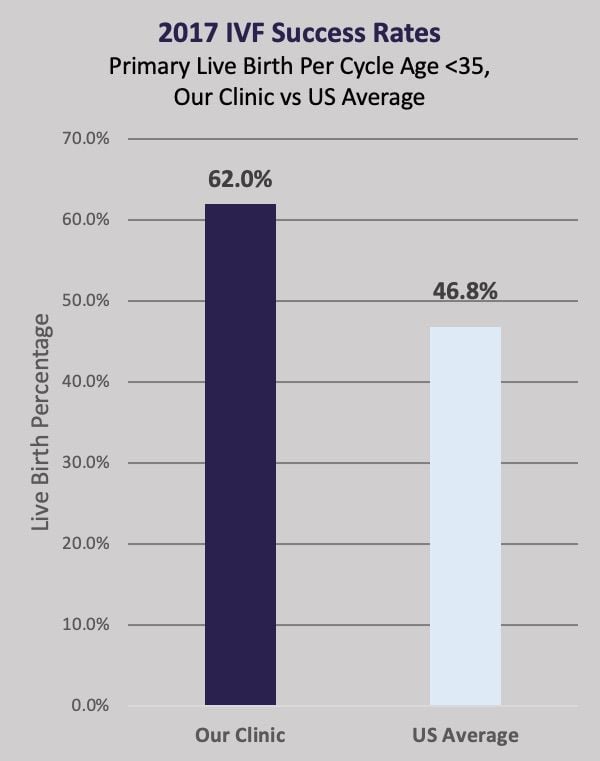Our IVF Success Rates Are Among the Highest in the Country
The Advanced Fertility Center of Chicago has set itself apart as one of the national leaders in IVF and egg donation success rates.
- Our statistics have been above the national average for 19 years in a row
Why Are Our Success Rates So High?
The ultimate goal is to help couples have children. To work toward this, our highly skilled team works diligently to stay on top of quality control. We make every effort to continually improve our knowledge base and methods.
Some reasons we are so successful:
- Use of the latest technologies
- Maintenance of stringent quality control
- Hiring and training the best people
- Commitment to ongoing learning
2017 IVF success rates
Our IVF success rate for 2017 was 62.9% per cycle and national average was 46.8%
2017 egg donation success rates Chicago
Our egg donation success rate for 2017 was 75.7% and national average was 50.7%
The tables below show our clinical and live birth success rates for 2013-2016
Treatments using fresh eggs/ embryos and frozen embryo transfers are shown separately
A “clinical pregnancy” has a pregnancy sac seen in the uterus on ultrasound exam
| Our 2016 IVF Clinical Pregnancy and Live Birth Success Rates Preliminary Primary Outcome Per Egg Retrieval IVF statistics for January 1, 2016 through December 31, 2016 |
||
|
Age
|
Cycles
|
Live Birth Rate
|
|
< 35
|
260
|
54% |
|
35-37
|
88
|
42% |
|
38-40
|
105 | 29% |
|
41-42
|
41 | 24% |
|
Egg Donation
Using fresh eggs Donor success rates |
40 | 88% |
| 2016 Frozen Embryo Transfer Statistics (Subsequent outcomes) FET Statistics for January 1, 2016 through December 31, 2016 |
||
|
Age
|
Frozen Embryo Thaws
|
Live Birth Rate
|
|
< 35
|
99
|
65% |
|
35-37
|
43 | 51% |
|
38-40
|
11
|
7 of 11 |
|
41-42
|
8
|
5 of 8 |
|
Egg Donation using frozen embryos
Donor success rates |
48 | 48% |
| Our 2015 IVF Clinical Pregnancy and Live Birth Success Rates – Fresh Cycles IVF statistics for January 1, 2015 through December 31, 2015 |
||||||
|
Age
|
Cycles
Started |
Embryo Transfers
|
Clinical Pregnancy Rate
Per Embryo Transfer |
Live Birth Rate
Per Embryo Transfer |
||
|
< 35
|
244 |
235
|
66%
|
58% | ||
|
35-37
|
69 |
68
|
68%
|
59% | ||
|
38-40
|
76 | 57 |
58%
|
42% | ||
|
41-42
|
25 | 17 | 24% | (4/17) | 18% | (3/17) |
|
Egg Donation
Using fresh eggs Donor success rates |
59 embryo transfers | 90% | 83% | |||
| 2015 Frozen Embryo Transfer Statistics FET Statistics for January 1, 2015 through December 31, 2015 |
|||||
|
Age
|
Frozen Transfers
|
Clinical Pregnancy Rate Per Transfer |
Live Birth Rate
Per Embryo Transfer |
||
|
< 35
|
111
|
72% | 65% | ||
|
35-37
|
42 | 57% | 48% | ||
|
38-40
|
30
|
67% | 57% | ||
|
41-42
|
2
|
100% | (2/2) | 100% | (2/2) |
|
Egg Donation using frozen embryos
Donor success rates |
55 | 66% | 47% | ||
| Our 2014 IVF Pregnancy and Live Birth Success Rates – Fresh Cycles IVF statistics for January 1, 2014 through December 31, 2014 |
||||||
|
Age
|
Cycles
Started |
Embryo Transfers
|
Clinical Pregnancy Rate
Per Embryo Transfer |
Live Birth Rate
Per Embryo Transfer |
||
|
< 35
|
230 |
217
|
66%
|
60% | ||
|
35-37
|
95
|
84
|
60%
|
48% | ||
|
38-40
|
61 | 53 |
47%
|
36% | ||
|
41-42
|
32
|
27 | 37% | 22% | ||
|
43-44
|
10
|
8 | 38% | (3/8) | 13% | (1/8) |
|
Egg Donation
Using fresh eggs Donor success rates |
73 embryo transfers | 85% Per embryo transfer |
78% | |||
| 2014 Frozen Embryo Transfer Statistics FET Statistics for January 1, 2014 through December 31, 2014 |
|||||
|
Age
|
Frozen Transfers
|
Clinical Pregnancy Rate Per Transfer |
Live Birth Rate
Per Embryo Transfer |
||
|
< 35
|
75
|
73% |
59%
|
||
|
35-37
|
55 | 78% | 63% | ||
|
38-40
|
19
|
63% | (12/19) | 58% | (11/19) |
|
41-42
|
6
|
67% | (4/6) | 50% | (3/6) |
|
Egg Donation
Using fresh eggs Donor success rates |
47 | 79% | 68% | ||
| Our 2013 IVF Pregnancy and Live Birth Success Rates – Fresh Cycles IVF statistics for January 1, 2013 through December 31, 2013 |
||||||
|
Age
|
Cycles
Started |
Embryo Transfers |
Clinical Pregnancy Rate
Per Embryo Transfer |
Live Birth Rate
Per Embryo Transfer |
||
|
< 35
|
236 |
228
|
66%
|
60% | ||
|
35-37
|
83
|
77
|
47%
|
35% | ||
|
38-40
|
63 | 52 |
62%
|
46% | ||
|
41-42
|
11
|
10 | 30% | (3/10) | 20% | (2/10) |
|
Egg Donation
Donor success rates |
84 embryo transfers | 83% |
77% | |||
| 2013 Frozen Embryo Transfer Statistics FET Statistics for January 1, 2013 through December 31, 2013 |
|||||
|
Age
|
Frozen Transfers
|
Clinical Pregnancy Rate Per Transfer |
Live Birth Rate
Per Embryo Transfer |
||
|
< 35
|
76
|
72% |
67%
|
||
|
35-37
|
33 | 58% | 49% | ||
|
38-40
|
15
|
80% | (12/15) | 53% | (8/15) |
|
41-42
|
9
|
67% | (6/9) | 33% | (3/9) |
|
Egg Donation
Using fresh eggs Donor success rates |
41 | 68% | 59% | ||
Check any clinic’s success rate – links to 2015 SART and CDC Reports
What Other Factors Affect IVF Success Rates?
In addition to the quality of the IVF program itself, other factors contribute to IVF success rates.
- Age of the female partner
- Cause of infertility
- Did the couple have a baby from a previous IVF, or did they have a failed IVF cycle?
- Quality and number of eggs
We Publish Our Success Rates – Some Clinics Do Not
If you go through in vitro fertilization, you need assurance that you have the highest chance of achieving your goal of bringing a new life into your family.
Why would so many clinics not show their success rates? Do they have something to hide? Maybe they don’t have the proven track record that we do. Do some research and see if you can find a clinic that matches our:
- High IVF Live Birth Success Rates
- IVF Pricing and Money Back Guarantees
How to increase your chance for having a successful IVF outcome
The best way to increase the success of IVF is by having the procedures done at a high quality IVF program. There are important differences in success rates between clinics. For example, if you go to the CDC (or SART) site, you will find clinics with IVF live birth success rates ranging from below 10% to over 60% per egg retrieval procedure for women under age 35.
Do your research before you do IVF.
We are proud of our IVF live birth success rates that have consistently been one of the highest in the Midwest every year.
However, don’t take our word for it. Follow the links below to go to either the SART or CDC websites to compare IVF live birth rates for reputable IVF centers.
Recently, some Chicago area IVF centers have advertised that their IVF success rates are “higher than the national average”. Unfortunately, some centers are being less than truthful (or they need math lessons). The CDC and SART reports for some of these IVF centers show success numbers consistently below the national average.
- Ask your doctor for their recent IVF success rate statistics in writing – then check their numbers on the CDC and/or SART reports.
- If you look for a specific IVF clinic on the CDC site and can’t find it – check the “CDC Non-reporting ART Clinics By State”. Look under your state to see if the program is listed as “non-reporting”.
- Some in vitro fertilization clinics break federal law by not reporting their IVF success results. That doesn’t say much for their integrity or their success rates.
Our goal is to have the highest live birth success rates possible, while minimizing risks of multiple pregnancy – particularly high-order multiples (more than twins).
- This is best accomplished by optimizing all laboratory and embryo culture systems, and by being cautious with the number of embryos transferred.
- Blastocyst embryo transfer is a technique that allows us to reduce multiple pregnancy risks, while maintaining high success rates.
- Our pregnancy rates with blastocyst transfer
Couples considering IVF can best evaluate the best clinic for them when they have a thorough understanding of the outcome results of any programs that they are considering.
You should ask for data like that presented above regarding IVF pregnancy success rates, live birth rates and multiple pregnancy rates from any clinic you are considering for IVF. These issues are critical, and you have a right to know the outcome information.
Any IVF program can provide this information in writing. If they refuse, or make excuses about why they can’t give you details in writing – consider going to another clinic</a href=””>. They probably have low success rates.
We are not bragging if we back it up. We do.
We put our money where our mouth is with 2 money back guarantee IVF pricing options for qualifying couples:
- Shared Risk IVF Plan pricing option
- 100% money-back guarantee option
IVF Costs:
Our IVF cycle price includes everything except medications for $10,000 (cash discounted price). The average charge at other centers is higher than this.
Many IVF clinics charge $12,000 or more. It is important not to equate price with quality when it comes to IVF. Some centers are expensive with low success rates.
Watch a video showing how to research IVF success rates online for any US clinic
A comparison of clinic success rates may not be meaningful because patient medical characteristics, treatment approaches and entrance criteria for ART may vary from clinic to clinic.




